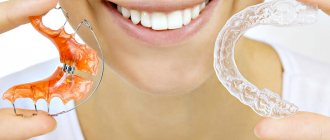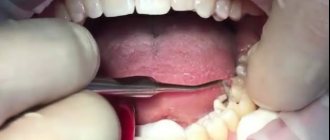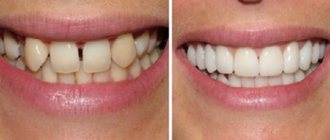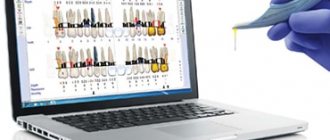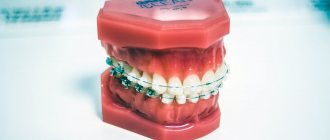Chief editor of the site:
Snitkovsky Arkady Alexandrovich
Chief physician of the professorial dentistry “22 Century”, dentist, orthopedic dentist
Author of the article:
Scientific team of dentistry “22 Century”
Dentists, candidates and doctors of medical sciences, professors
Dental prosthetics is a sequential multi-stage process. It is the high-quality implementation of each of them that leads to an excellent final result. There are main stages of prosthetics , some of them have their intermediate stages. They can also be clinical, that is, performed in a doctor’s office, and laboratory, in a dental laboratory. The main ones include: examination, preliminary treatment, prosthetics. The last stage includes the restoration of supporting teeth , their preparation, taking impressions, determining the closure of the jaws, fixing temporary structures, fitting and fixing permanent dentures and an adaptation period. Laboratory stages are carried out by a dental technician after taking impressions and determining occlusion (closing of the jaws). Before starting any treatment, it is necessary to draw up a treatment plan.
Oral examination
Any treatment process must begin with an examination. A preliminary examination allows you to determine the need for prosthetics, choose the optimal type of design and amount of work.
Examination of the oral cavity in dentistry Additional examination (instrumental, x-ray, etc.) provides information about the condition of the supporting teeth, periodontal tissue, bone tissue, the need for root canal treatment, and the possible presence of inflammatory elements at the tops of the root canals or in the bone.
This is an integral stage of successful prosthetics, as it allows not only to identify and eliminate hidden problems, but also to avoid possible complications in the future, after installation of the prosthesis .
Preliminary treatment
Dental treatment is an important point not only before prosthetics or implantation, but throughout life. Timely sanitation of the oral cavity preserves the health and integrity of the dental system, avoids possible complications, as well as the spread of infection throughout the body. Treatment of abutment teeth , hidden and obvious carious cavities, acute inflammatory processes in periodontal tissues or bones is mandatory before starting any prosthetics. This will allow not only to eliminate defects or diseases that have arisen in a timely manner, but also to extend the service life of the prosthesis. Also, some fixed structures require mandatory endodontic treatment.
Who is eligible to receive
A quota for free dental prosthetics is primarily provided to heroes, disabled people and war veterans, as well as children with disabilities - these patients receive the service ahead of others.
However, patients with oncology or those who have recently undergone a complex operation on the gastrointestinal tract, as well as people faced with the problem of missing teeth due to serious injuries to the maxillofacial apparatus, can also be served out of turn. Naturally, such patients must confirm their status with relevant documents, extracts and doctor’s prescriptions.
Old-age pensioners, people with disabilities and labor veterans can receive benefits on a first-come, first-served basis.
Stages of dental prosthetics
Rarely does dental prosthetics happen in a single stage; generally, it is a sequential, multi-stage process. After preliminary endodontic treatment, it is necessary to restore the supporting teeth using inlays or pins. Then the doctor prepares (grinds) them to create a place for the prosthetic structure, takes impressions from both jaws and the prosthetic area, and determines the color of the artificial teeth. A very important step in prosthetics is determining the occlusion (the relationship of the jaws), which allows you not to interfere with the prosthesis during chewing. The impressions are sent to the dental laboratory. This is a kind of information for a dental technician about the shape and size of the teeth, the anatomical features of the prosthetic bed, the location and type of structure. Based on the impressions obtained, the dental technician casts diagnostic and working models from plaster, which are an exact copy of the teeth, and in the case of complete edentia, the gums. Next, the structure itself is modeled with wax and the prosthesis itself is created using various methods and techniques. Sometimes during its manufacture it requires checking, fitting and fitting. The finished structure is fixed in the oral cavity. In some cases, additional correction of the prosthesis is required during the adaptation period.
Example of a content matrix for a dentist’s social networks
We share the promised content plan for a dental account on Instagram or another social network. We compiled it taking into account the specifics of the niche and added different types of posts from those discussed in the article.
Example of a content plan for a dentist
Content plan template
The file is located on Google Drive and can be copied. Get a ready-made content plan for a dentist for two weeks using the link and adapt it to suit you.
Stages of dental prosthetics with metal-ceramics
process of metal-ceramic dentures begins with the preparation of previously prepared abutment teeth and obtaining a two-layer impression.
Bridges They are removed with special elastic masses, which allows the dental technician to accurately convey information about the shape, size and location of the teeth and the orthopedic structure.
Next, temporary crowns or bridges are fixed onto the prepared teeth in order to temporarily restore the cosmetic defect and prevent changes and displacement of the tissues of the prosthetic bed. Central occlusion is determined - the nature of the closure of the teeth of both jaws. All received data is transferred to the dental laboratory. At the next visit, the solid metal frame of the prosthesis is fitted and the color of the ceramic veneer is determined and sent back to the laboratory for ceramic veneering. On the third visit, the doctor fits and temporarily fixes the finished metal-ceramic prosthesis . Sometimes at this visit the prosthesis is fixed with permanent cement. Temporary fixation allows, if necessary, to adjust the prosthesis during the adaptation period.
Fixation of dentures
Fixing agents are used only if removable dentures are installed, since they allow the structure to stay more firmly in the oral cavity and also have a shock-absorbing effect, reducing irritation of soft tissues. Most of these products also have antibacterial properties.
Cream for fixing dentures
These include:
- fixing creams, gels, adhesives - they are applied to the surface of the prosthesis adjacent to the patient’s tissues, strictly according to the instructions (some are applied only to dried mucosa); Please note that creams and gels have different durations of action: the widely advertised Corega cream lasts 3–4 hours, Rocs cream lasts up to 12 hours (optimal duration), and Lacalut - 24 hours; You should also keep in mind that some fixatives contain zinc, which has a good anti-inflammatory effect; but with prolonged use of such drugs, an overdose of zinc occurs, which is harmful to the body, therefore zinc-containing fixatives can only be used in courses of 3 to 4 weeks with long breaks;
- powdered products - sprayed onto the surface of the removable dental prosthesis, then the product is put on in the usual way and lightly pressed against the gums and palate;
- strips of fabric - designed to tightly fix a removable denture in the absence of teeth and make it more comfortable to wear.
An orthopedic dentist will help you choose the right fixation agent.
Stages of dental prosthetics with inlays
Ceramic inlays are a type of microprosthetics, which is a modern alternative to conventional fillings. They fill previously prepared cavities in the teeth, restoring their shape and function. The indication for ceramic inlays is the ability to save a tooth with significant destruction of its coronal part (up to 65%).
At the initial stage of tooth preparation, the doctor removes all tissue destroyed by the carious process and, if necessary, carries out endodontic treatment. After the tooth is cured, an impression is taken and sent to the laboratory, where a ceramic inlay is made . At the next visit, the finished structure is fixed to the tooth using special cement. Ceramic inlays have high strength and durability, and are color resistant to food coloring. They are also highly aesthetic.
Stages of dental prosthetics with complete edentia
The production of a complete removable denture begins with an examination of the patient’s oral cavity, diagnosis of the condition of the dental system, and selection of a suitable design. The first impression is taken with a standard impression tray. Depending on which design is chosen, the impression mass is selected. The impressions are sent to the laboratory, where a dental technician casts plaster models and makes a wax base with occlusal ridges and custom impression trays.
On the second visit, using these trays, the doctor takes functional impressions, and using rollers, determines and fixes the occlusion. All information is transmitted to the dental technician. He makes the future prosthesis from wax with acrylic (plastic) teeth .
On the third visit, the structure in the oral cavity is checked, occlusion, fit, and the appearance of the patient’s face are assessed. The doctor makes the necessary notes and corrections and transfers the future design to the laboratory. The dental technician finally models the wax structure, plaster it into a cuvette where the wax is replaced with plastic. Next, he grinds and polishes the finished prosthesis.
At the next visit, the prosthesis is handed over. Finished structures are fitted, fit, occlusion and aesthetics are checked. The doctor will tell the patient how to use and care for the new prosthesis. During the adaptation period, additional corrections are possible.
Which material is better and will last longer?
The material from which the prosthesis is made has the greatest impact on wearing comfort, and this is especially true for removable systems. If no errors were made during the manufacture of the structure itself, but the prosthesis still causes significant discomfort, then the problem is most likely due to the poor quality of the material. Of course, no such system can provide 100% convenience (especially at the adaptation stage), but modern materials make it possible to achieve very high performance. So, what qualities should the best materials for dentures have:
- Hypoallergenic.
Many people are allergic to plastic and acrylic. - "Friendly" to gums.
If the denture rubs your gums too much, wearing it will be a complete pain. - Color fastness.
Immunity to staining and environmental influences. - Acceptable strength.
Despite the fact that a removable denture rarely lasts more than 5–6 years, the structure should not be overly fragile.
If we talk about specific brands of removable dentures, the best acrylic denture is considered to be Acry-Free (“Acry-Free”) made from acrylic-free plastic: it is very comfortable, does not shrink when worn, does not stain and does not cause allergies. The best nylon dentures at the moment are the Quattro Ti brand. However, “Quadrotti” has restrictions on its use: to install them, one of the jaws must have several healthy teeth, however, like other clasp-type dentures. As for non-removable systems, metal-free structures are increasingly being used, which look more aesthetically pleasing and do not cause allergies, but are also less durable.
Stages of prosthetics with veneers
Veneers are thin ceramic plates that are fixed to the front surface of previously prepared teeth and allow them to correct cosmetic defects, change shape, size and color.
Crowns and veneers The first stage, as with any prosthetics, is a survey, examination and
diagnosis of the oral cavity .
If necessary, X-ray and laboratory tests are performed. A very important stage is planning future structures, taking into account not only the condition of the teeth and oral cavity, but also the gender, age, and character of the patient. The shape of the face, the gingival margin and smile line, and the individual characteristics of the teeth are assessed. The size of the veneers is predicted and calculated. A photographic record is being taken. The doctor models the future restoration on a computer using a special program and demonstrates the result to the patient. At the next visit, the teeth are prepared, starting with cleaning their surfaces from plaque. The required shade of filling material is selected. Under anesthesia, the front surface of the teeth is prepared and the required amount of enamel is removed. The next step is taking impressions. Based on the dental impressions obtained, a plaster model is cast in the laboratory to obtain an exact copy of the patient’s teeth, on which the dental technician makes future veneers. After the doctor has prepared the teeth, temporary veneers . A dental technician, using computer systems, special scanners, sensors and ovens, produces structures strictly according to the specified parameters.
At the next visit, the doctor tries on the finished structures. If necessary, adjustments are made, deficiencies are eliminated, and the bite is checked. Veneers are fixed to the teeth using special cement.
Dentistry name that makes a profit
Sometimes the choice of dentistry depends on the impression the name gives. Funny or incomprehensible - causes mistrust of customers, solid and original - attracts attention.
What should you name your dentistry to attract clients? Use these rules:
- Use simple words that are easy to remember and write down. The client should easily find it via the Internet or a directory. For example, “Megadent”, “Clinic 32”, “Nova Dent”.
- The name should not cause negative or unpleasant associations. For example, the names “Kiss”, “Gamma”, “Dental Shop” evoke the feeling that the clinic provides low-quality services.
- The name should reflect some distinctive feature of dentistry. Emphasize the range of services, location, clinics or line of business. For example, children's dentistry “Zubastic”, “Baby Smile”, “Dentistry on Proletarskaya”.
- Be original, be sure to study examples of competitors' names so as not to repeat them. The easiest way to name dentistry in an original way is to use the name of the chief physician. “Dr. George’s Dentistry”, “Dmitrovich and Colleagues”, “Dr. Zorin Implantation Center”.
